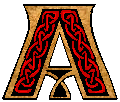 is for Ailsa Craig, an island in the outer Firth of Clyde on the southwest coast of Scotland, and the traditional source of the stones used in curling around the world. The extremely fine grain and homogeneity of the granite quarried on Ailsa Craig made it ideal for use in Curling rocks, which must withstand years of crashing and banging, and more importantly, freezing and thawing. Almost seventy percent of the curling stones currently in use around the world came from Ailsa Craig.
is for Ailsa Craig, an island in the outer Firth of Clyde on the southwest coast of Scotland, and the traditional source of the stones used in curling around the world. The extremely fine grain and homogeneity of the granite quarried on Ailsa Craig made it ideal for use in Curling rocks, which must withstand years of crashing and banging, and more importantly, freezing and thawing. Almost seventy percent of the curling stones currently in use around the world came from Ailsa Craig.
The quarry was closed in 1971, and the island was made a bird sanctuary. It is noted for its population of Gannets, and much has been made of the return to the island of a small colony of Puffins. Most new curling stones now come from a quarry in Wales.
More recently, a Scottish company received permission from the Scottish government to begin removing granite from Ailsa Craig again. No new quarrying is being undertaken; the company is merely removing large, loose granite boulders left behind when the quarry closed. The 2002 women's Olympic curling gold medal winners from Scotland used new rocks made specially for them from Ailsa Craig granite.
January 26, 2009
The ABCs of Curling
Labels:
ABCs of curling
Subscribe to:
Post Comments (Atom)







4 comments:
Can we expect, intermittently, to see 25 more of this sort of post? Because that would be pretty fascinating, I think. I knew most of the world's stones had come from Scotland; I didn't know they originated primarily from a single quarry. Cool!
I never knew that .. even though I grew up in a curling club.
An excellent start.
When you first mentioned doing this, I kind of figured it was dopey.
You just love proving me wrong don't you?
Brent
I'm hoping there will at least be a "B" and "C" entry. I know absolutely nothing about curling except that it's fascinating when I see it during the Winter Olympics. It looks like something that anyone could do, but I suspect that it takes a lot of skill and practice to be able to do it well. Like most sports, I suppose.
Post a Comment